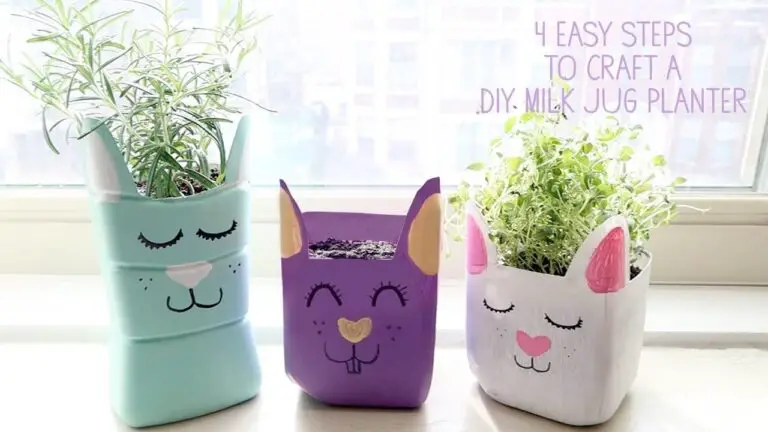16+ Different Types Of Begonias
While wax begonias may be the most well-known varieties, there are actually over 10,000 species of this plant, making it a vast and diverse group. Despite their widespread popularity, many people are unaware of the incredible range of begonia types that exist. In fact, these shade-loving plants have been bred to thrive in various conditions, from annuals to perennials, with different varieties featuring unique characteristics like double flowers or trailing stems.
This article aims to give you a glimpse into the world of begonias, highlighting 16 distinct types and providing an overview of their characteristics, care requirements, and more. From flowering begonias to rhizomatous begonias, each type has its own set of traits that make it suitable for specific environments and uses.
Begonia facts
While begonias may seem like a humble houseplant, they have a rich history and fascinating characteristics that set them apart from other plants. With over 2000 species thriving in tropical and subtropical regions, begonias have adapted to store water in their succulent stems, allowing them to survive during dry periods.
One of the most interesting aspects of begonia reproduction is the production of winged capsules, which contain dried seeds that can be planted in spring after being preserved over winter. Among the three main types of begonias – tuberous, semperflorens, and perennials – it’s worth noting that the edible varieties, such as tuberous and semperflorens, have a citrusy flavor and are related to the pumpkin, squash, and gourd family.
Interestingly, begonia seeds are considered the smallest in the flower world. The name ‘begonia’ originates from Michel Begon, an amateur botanist who sent navigations to the Americas where the plant was discovered in the 1600s. Furthermore, the Begonia Kimjongilia is the state flower of North Korea, and in medieval times, begonias were even used to polish sword blades.
Begonia symbolism
Begonias carry multiple meanings and symbolisms, just like other flowers and plants. While some interpret them as a warning of bad luck or tragedy, others see them as symbols of harmony, justice, and gratitude. The plant is also believed to represent the process of working through relationships by fostering open communication. In ancient cultures, begonias have been linked to myths and folklore.
For example, in Greek lore, it’s said that a woman can dream of her true love if she wears down her hair and places a begonia near her heart before sleep. In Chinese traditions, particularly feng shui, the plant is associated with the fire element, conveying caution but also revelation and progress. Furthermore, begonias are sometimes given as a symbol of ‘no rush’ in arranged marriages.
As a tattoo, begonias can be open to various interpretations, but they’re often seen as representing love, compassion, open-mindedness, and personal growth.
16 types of begonias
Flowering begonias

While Rieger begonias are renowned for their vibrant flowers, which surpass the showiness of wax varieties, they present a more nuanced character. As houseplants, they thrive in cooler temperatures, but demand more precise care to maintain their beauty. The Solenia series stands out as its most celebrated variety, with five notable colors: Dusty Rose, Velvet Red, Apricot, Cherry, and Light Yellow.
Rex begonias

Rex begonias are a type of rhizomatous begonia characterized by their striking foliage. While their flowers may be small and unassuming, it’s the vibrant leaves that truly make them stand out. As popular houseplants, rex begonias offer a range of stunning varieties to suit any decor.
If you’re looking for showstoppers, consider the following standout species: Tornado rex begonia boasts dark green leaves adorned with silver and bronze patterns and deep purple splotches; Ballet rex begonia features silver-green leaves on red stems with reddish margins; Fairy rex begonia presents silver leaves with subtle shades of cream and pink, as well as dark green veins; Pink Charming rex begonia offers light pink foliage with hints of silver and green hues; Duarte rex begonia boasts pointy, veined foliage in shades of silver and bronze.
Angel wing begonias
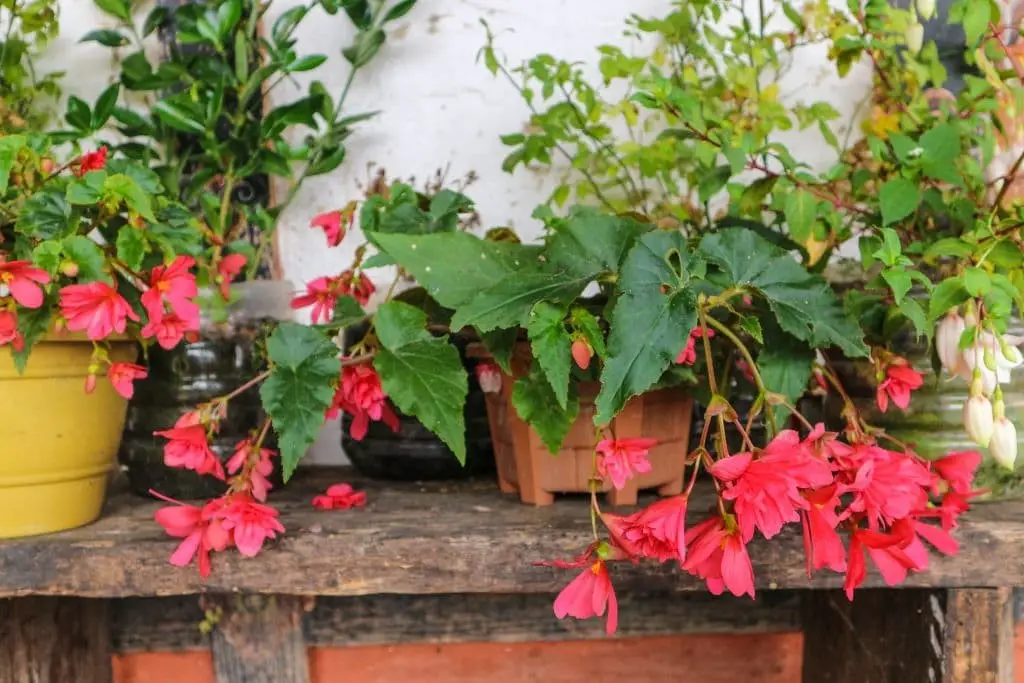
Cane begonias, also known as bamboo-like Begonia semperflorens, are distinguished by their distinctive spotted leaves and clusters of flowers. Their stems, which have an arching habit, make them a popular choice for hanging baskets in home decor. With one of the broadest ranges of varieties among houseplants, cane begonias offer a diverse selection.
Some notable cultivars include Silvermist, Elizabeth Lahn, Fancy Face, Pink Jade, California Dreaming, and Down Home Dan Thompson, each boasting unique characteristics that set them apart from others.
Tuberous begonias
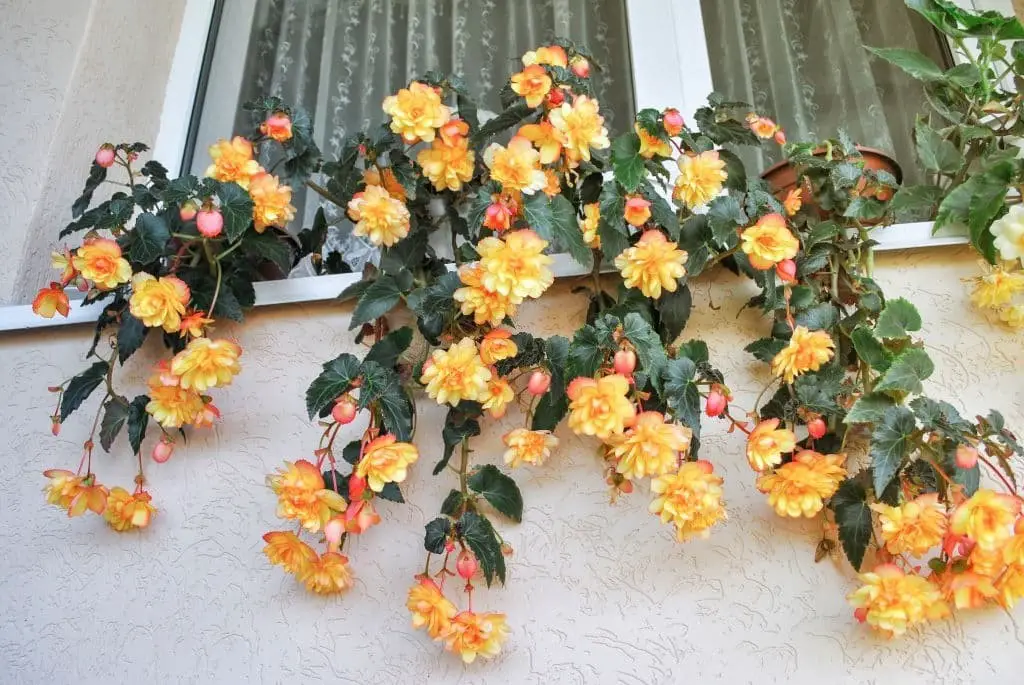
Tuberosa Begonias are instantly recognizable by their vibrant, showy blooms that burst forth from mid-summer to fall. What’s unique about this group is the potato-like tubers they produce, which can be carefully uprooted and replanted as annuals. Interestingly, these begonias thrive in both indoor and outdoor environments, making them a versatile addition to any space.
Some of the most popular cultivars include the Dragon Wing series, Encanto Orange, Hanging Basket series, and Lace Apricot varieties.
Wax begonias
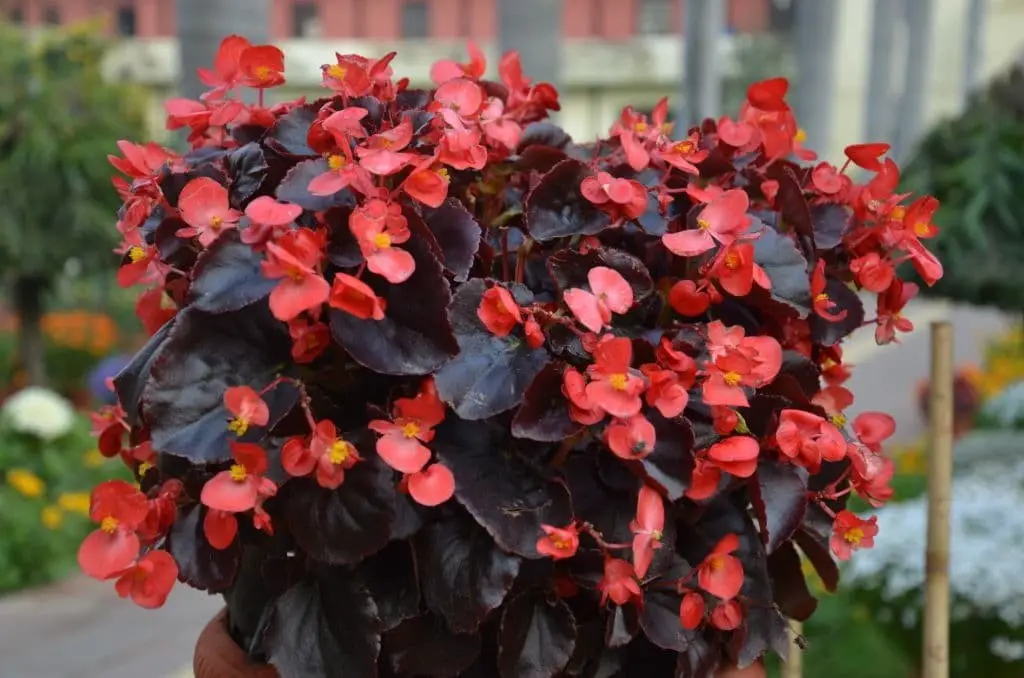
These fibrous-rooted begonias, also known as Begonia spp., are characterized by their unique root systems, where the root balls are encapsulated within the roots. One of the most distinctive features of these plants is their small, waxy leaves, which support tiny flowers that can thrive even in low-light conditions.
What’s more impressive is that some species of begonias can survive the harsh winter months if placed near a bright and warm location, making them a popular choice for indoor gardening.
Hardy begonias
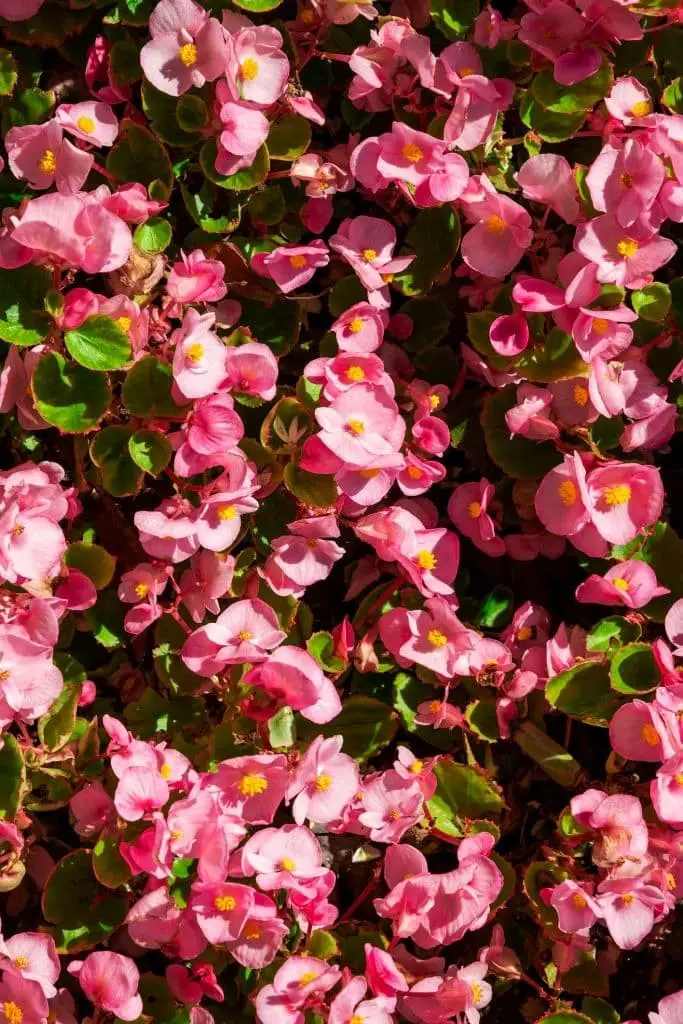
Begonia grandis, also known as the Begonia grandis species, boasts exceptional hardiness. In fact, this type of begonia thrives in southern gardens or USDA zone 6. One notable characteristic is its tuberous root system, similar to that of tuberous begonias. However, the flowers are limited to a palette of white and pink hues.
If you’re seeking robust and resilient begonias for your garden, consider starting with the following varieties: Garden Angel Blush, Garden Angel Plum, Garden Angel Silver, Heron’s Pirouette, and Alba.
Rhizomatous begonias
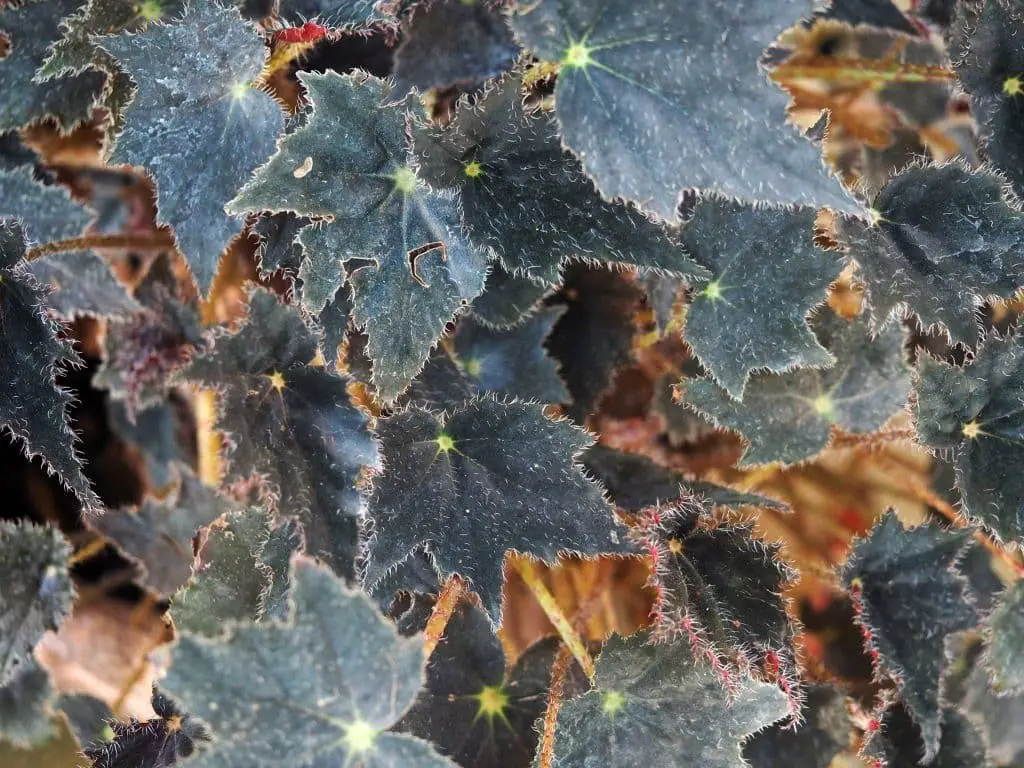
Begonias with creeping stems and fleshy roots, commonly grown as houseplants for their striking foliage and ability to cover large areas, are a popular choice among plant enthusiasts. Their unique characteristics have led to the development of numerous varieties, some of which include Escargot, Fireflush, Iron Cross, Marmaduke, and Ricinifolia.
Double begonias
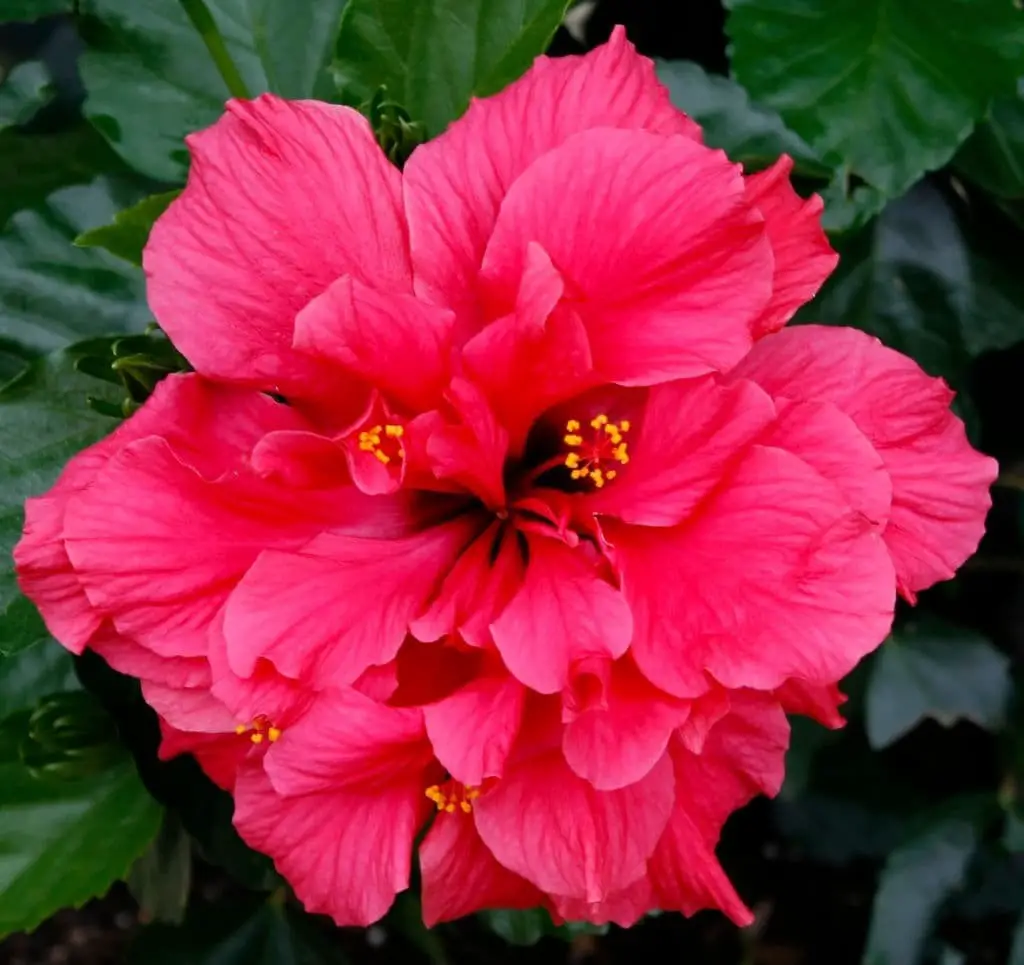
The Roseform series of double begonias boasts a unique characteristic that sets them apart from other varieties – their flowers resemble those of roses. These compact, bushy plants produce large, double blooms in a range of vibrant colors including white, orange, pink, and red. Their upright growth habit makes them ideal for container gardens or as bedding plants in landscapes. The foliage is dark green, oval-shaped with serrated edges adding to their overall appeal.
Fimbriata begonias
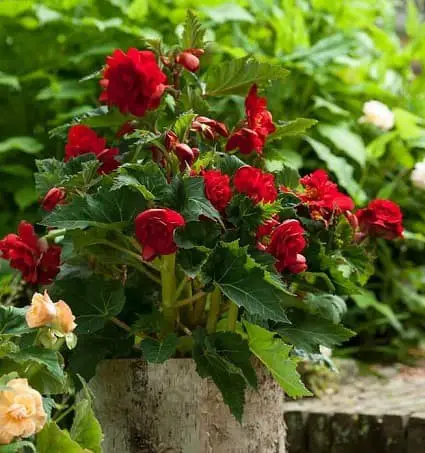
In contrast to some varieties, these flowers bear a striking resemblance to carnations due to their robust, fleshy stems and intricately fringed petals that droop gently, showcasing hues of peach, pink, and white. The foliage, a deep green with serrated edges, also exhibits a subtle downward curve. While they can thrive as annuals in containers, these flowers are equally well-suited for borders within the landscape.
The ‘ruffled red’ cultivar remains particularly popular among garden enthusiasts.
Hanging begonias
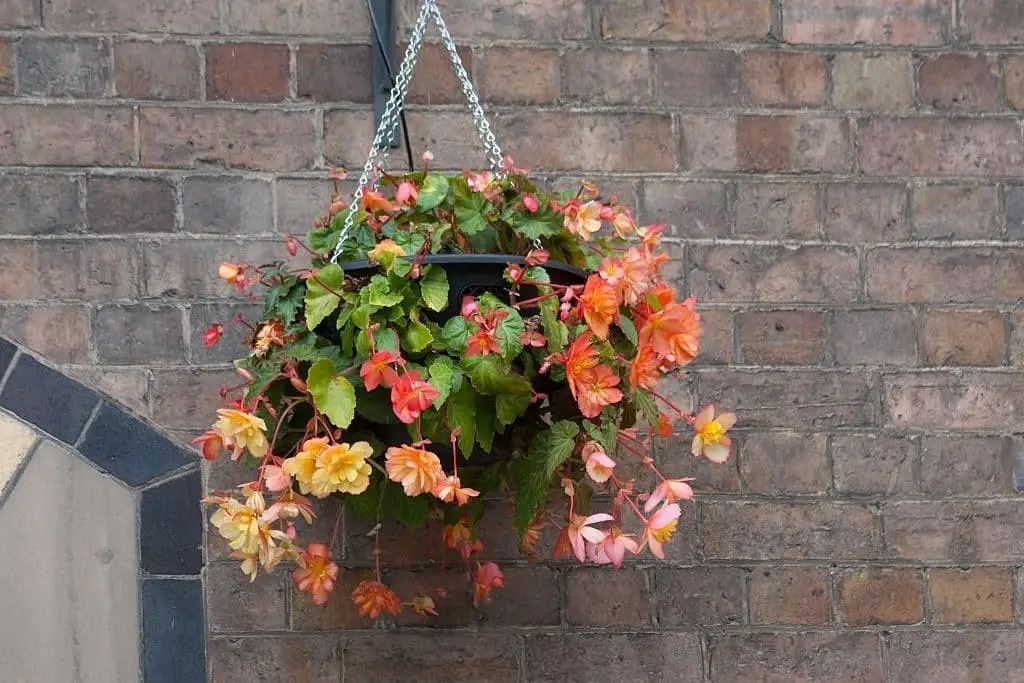
Begonias are particularly well-suited for hanging baskets due to their unique, drooping habit that allows them to cascade elegantly. Additionally, they are prolific bloomers, producing large, showy flowers in a range of vibrant colors every month. This versatility also makes them ideal container plants, perfect for window boxes or other small spaces. With their striking shades and colors, begonias have the ability to instantly brighten up any room.
Some of the top cultivars to look out for include the Cascade pink, Pendula white, Cascade white, Cascade red, and Bertini varieties.
Double picotee begonias
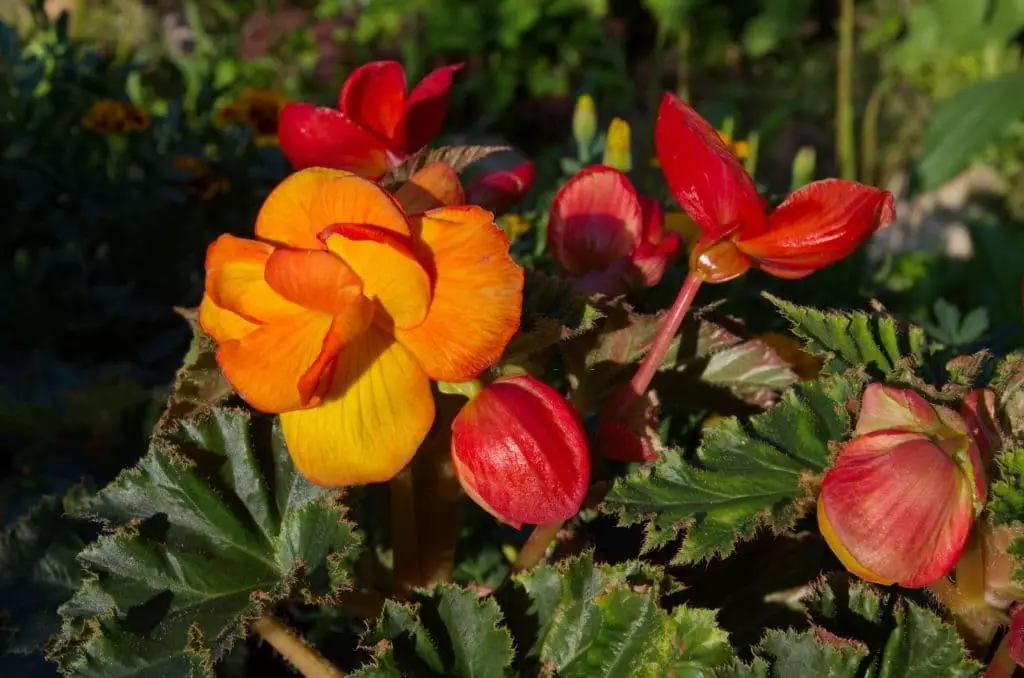
Two-toned begonias, also known as double flowering begonias, are a stunning addition to any landscape. Their rose-like blooms and upright growth habit make them an eye-catching focal point when paired with solid-colored varieties. The key to showcasing their beauty is to provide the right conditions: shade. These begonias have limited tolerance for heat and require protection from direct sunlight to thrive.
If you’re looking for inspiration, consider these gorgeous double picotee begonia varieties: All that Jazz, Bridesmaid, Calypso, First Love, Lace Mix, Ruby Dalmatian, Sunburst, or Red Edge.
Non-stop begonias
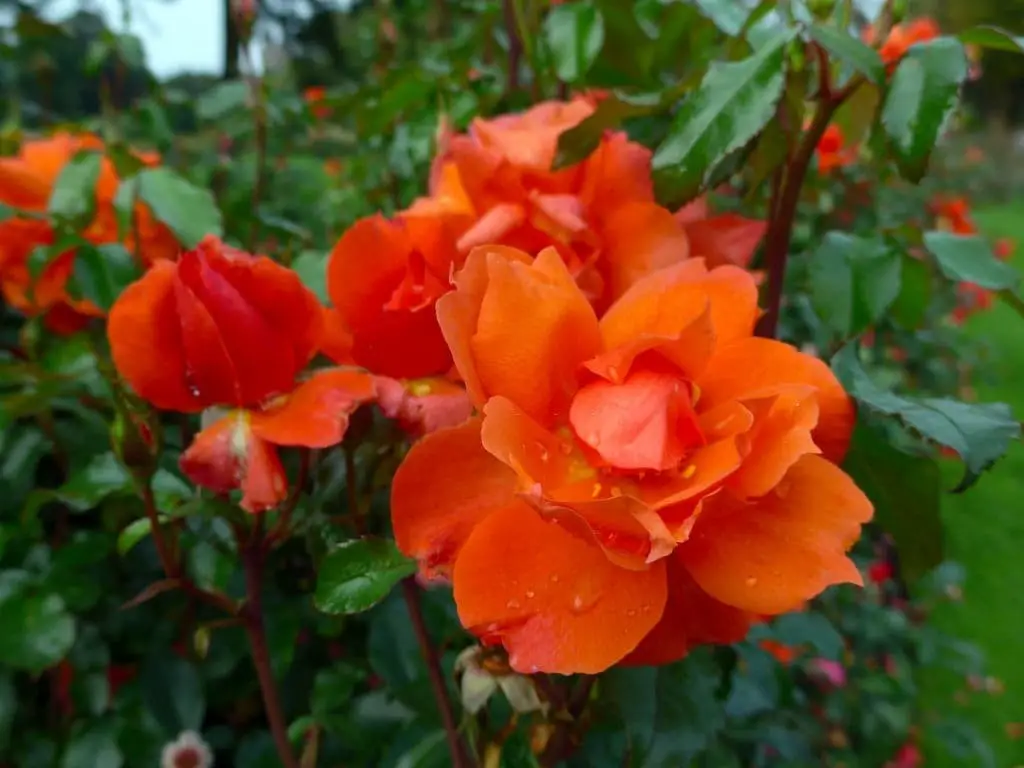
The non-stop begonia hybrid series is characterized by its perpetual blooming habit, producing small, two-toned flowers from late spring to early autumn. These blooms come in a vibrant palette, featuring shades of bright yellow, rose pink, orange, and white, often accented with subtle splashes of pink. Notably, these begonias are among the most compact varieties, making them an ideal choice for container gardens.
As a subtype of tuberous begonias, this series is distinguished by its ability to thrive in a range of environments.
Dragon wings begonia
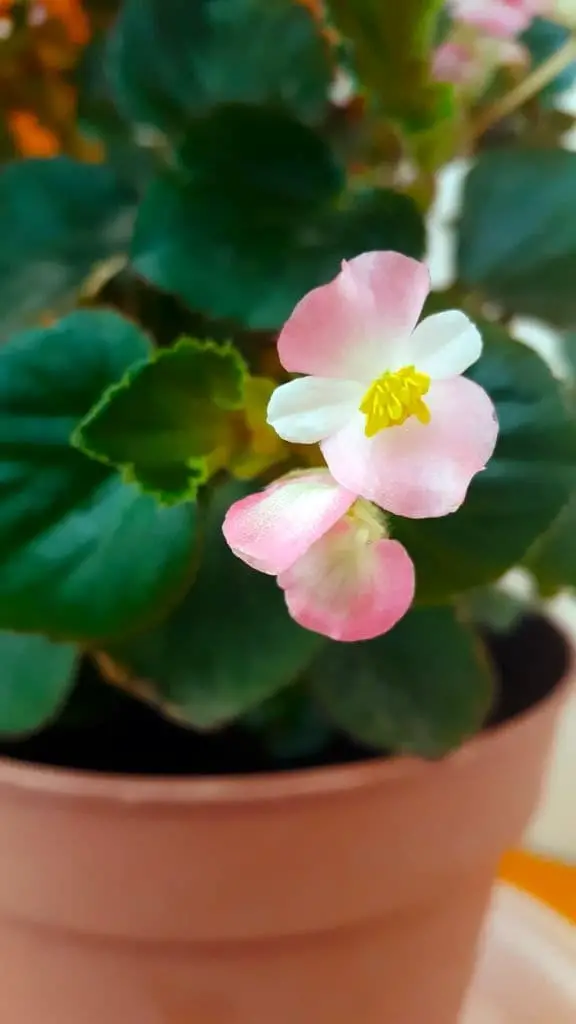
The begonias’ trailing flower clusters make them ideal for showcasing in hanging baskets. While they prefer filtered shade, their beauty can also be appreciated indoors when placed in a bright location. The delicate flowers come in a range of colors including white, red, and pink, and bloom repeatedly from spring to fall with minimal interruption.
Additionally, the stems are slender yet fleshy, while the foliage is characterized by its oval shape, lancing edges, glossy texture, and subtle pink outline.
Multiflora begonias
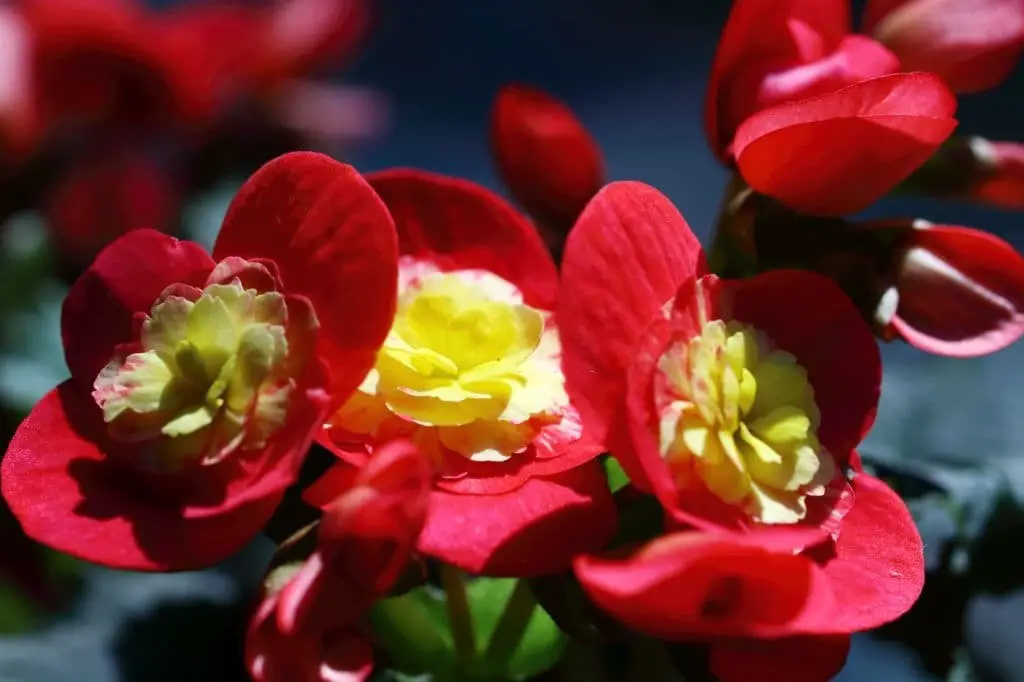
When it comes to containers and hanging baskets, tuberous begonias are an excellent choice. They flourish in environments with dappled light and plenty of shade, making them a great option for gardens that require plants that can thrive in less intense sunlight. One of the unique features of these flowers is their clusters of blooms that droop down from a single stem, creating a dramatic display.
With a wide range of vibrant colors to choose from, including yellow, pink, scarlet, salmon, and apricot, they’re perfect for adding a pop of color to your garden. Some of the most popular varieties include Floribunda carriere, Folioso, Fulgens, Miniata, and Tittelbachia.
Interspecific begonias

Begonias often get mistaken for their wax counterparts, but they boast larger blooms and a more prolific blooming habit. These stunning flowers come in a range of colors including red, pink, and white, with the showy display continuing from mid-spring to early winter. When it comes to sought-after varieties, Whopper and Big series are among the most popular.
However, if you’re looking for something unique, be sure to keep an eye out for the following interspecific begonias: Barbara Rogers, Emperor Red, Monza, Party Pink, Prelude White, and Senator Red.
Bolivian begonias

In South America, particularly on the cliff sides of Peru and Bolivia, a unique species of begonias thrives. These wild begonias are characterized by their small, pendulous flowers that grow downwards from dainty stems. The natural palette is dominated by shades of red and orange, but modern hybrids have introduced new hues like pink, yellow, and bi-colored varieties. As a result, they’re incredibly versatile and can be showcased in hanging baskets or containers.
Some notable cultivars from Bolivia include Bonfire, Bossa Nova Pure White, Million Kisses Elegance, Mistral Pink, San Francisco, and Santa Cruz.
Begonia plant care
When you’ve become enamored with one of these begonia types, it’s essential to understand their care requirements. A key aspect is providing the right amount of sunlight – specifically, mid-day sun and afternoon shade. For indoor growth, they require bright indirect light. When it comes to soil, begonias prefer well-draining soils; if grown in containers or hanging baskets, a soilless potting mix would be an excellent choice.
Watering should only occur when the top layer of soil starts to dry out, as these plants thrive on moisture but can be susceptible to rot if too wet. Additionally, fertilizing every other week with a balanced liquid fertilizer is recommended – just be sure to stop in the winter, as begonias typically stop growing during this time.
Where to buy begonias?
When it comes to acquiring begonias for your outdoor space, there are several stores where you can find a diverse selection of cultivars. From online retailers to local nurseries and greenhouses, here are some popular options to consider: Amazon, American Meadows, Eden Brothers, Evergreen Nursery, Kartuz Greenhouses, Glasshouse Works, Grow Joy, Logees, Longfield Gardens, Lyndon Lyon Greenhouses, Mountain Orchids, Palm Hammock, The Violet Barn, and Tropical World Nursery.
White Flower Farm is another great destination for begonia enthusiasts.
FAQs
When cultivating various begonia species, having a solid understanding of their cultivation requirements is crucial. To ensure success, it’s vital to have a comprehensive grasp on planting, care, and propagation techniques. As such, the following FAQs provide valuable insights into the world of begonias.
How many types of begonias are there?
While it’s common to categorize begonias by their various subtypes, it’s worth noting that there are actually at least 14 distinct types within this plant family. What’s more impressive is that begonias comprise an astonishing 2000+ species in total, with the majority of these being hybrid varieties. This staggering diversity is a testament to the adaptability and resilience of begonias as a species.
What type of soil is best for begonias?
When it comes to growing begonias, having the right soil conditions is crucial for their survival. Ideally, they prefer well-draining soils or a specially formulated potting mix that combines perlite/vermiculite, coco coir, and a light, free-draining base. This allows their roots to breathe easily and prevents waterlogged conditions that can be detrimental to the plant’s health.
Are begonias poisonous to pets?
When it comes to the feline realm, a common substance that warrants caution is the capsaicin found in chili peppers. If a curious cat were to encounter this spicy compound on their mouth area, they would likely experience an unpleasant combination of irritation and intense burning. In more severe cases, ingestion could lead to a range of unpleasant symptoms, including uncontrolled drooling, vomiting, and difficulty swallowing.
Interestingly, while capsaicin can cause significant distress for our feline friends, it is not toxic to canine companions.
Are begonias deer resistant?
While some plants may be able to withstand the grazing of deer, it’s interesting to note that only those with waxy or fuzzy stems appear to possess this level of resistance. In contrast, the majority of plants without these characteristics are more susceptible to deer damage and will likely suffer if nibbled by these voracious herbivores.
Do all begonias spread?
While the majority of begonias don’t possess rapid-spreading tendencies, it’s worth noting that the fibrous and waxy varieties are exceptions to this rule. One of the advantages of these fast-spreading begonias is that they’re not considered invasive, making them a popular choice for gardeners who want to avoid potential problems with unwanted plant growth. Additionally, these spreading begonias possess another benefit – they’re deer-resistant, meaning they won’t be damaged by hungry herbivores.
When used as ground cover, these begonias are particularly effective at filling in gaps and covering areas, with a spread of around 6-12 inches.
Is it true that begonias have health benefits?
Begonias possess a plethora of nutrients, including saponins, flavonoids, and alkaloids, which are renowned for their medicinal properties. This unique combination also comprises essential minerals like magnesium, calcium, and Vitamin C. For centuries, people have harnessed the plant’s benefits by boiling it as a tea to reap its advantages. Some of these advantages include the treatment of dysentery, alleviation of asthma, bronchitis, coughs, and flu symptoms.
Additionally, begonias can be used to brighten one’s complexion, promote digestive health, and alleviate rheumatoid issues. Furthermore, it has been traditionally utilized to help with bleeding problems.
What are the top 10 most popular begonia varieties?
When seeking the most sought-after begonias, it’s essential to explore a diverse range of options.
To get you started, consider the following top-notch varieties: Bellagio, renowned for its apricot, blush, and pink hues; Big Red, a bold and vibrant choice; Big Rose, offering a romantic touch with its rose-colored blooms; Bonfire Cocktail, a unique combination of vodka and whiskey-inspired colors; Doublet, featuring stunning rose and white color combinations; Dragon Wing Red, a fiery addition to any garden; Mandalay Pearl, boasting lustrous white flowers; Sprint Scarlet, a speedy and eye-catching option; Super Olympia Coral, showcasing vibrant coral tones; Whopper, the largest and most impressive begonia variety.
These popular options are sure to satisfy your desire for the finest begonias.
Are begonias annuals or perennials?
While begonias are technically perennials, their hardiness varies depending on the climate. In zones 3-9, they’re often grown as annuals due to the colder temperatures. This adaptability has contributed to their popularity as versatile houseplants.
Which begonias need the most sun?
When it comes to begonias, some varieties thrive in direct sunlight, particularly those from the wax begonia family. The ones with striking bronze leaves are no exception, as they require ample sunlight to reach their full potential. Another type that enjoys basking in the sun’s warmth is the angel wing begonia. However, these plants do need a gentle reminder to move into the shade during the hottest part of the day, typically around the afternoon hours.
What species are considered as rare begonias?
For enthusiasts of rare plant species, particularly begonias, the following varieties are worth exploring. From unique patterns to striking colors, these Begonia species showcase exceptional characteristics that set them apart from others in the same family. The Aureo maculata boasts intricate golden markings on its leaves, while the Blancii variegata features delicate white and green stripes.
The Brevirimosa is a compact plant with remarkable leaf shapes, while the Sizemorae and Dregei possess striking foliage patterns of their own. For those seeking something more vibrant, the Luxurians offers lush, velvety leaves in various shades. Rounding out this list are the Polka dot begonia, Painted leaf begonia, Begonia tie dye, and Voodoo, each with its distinct charm and visual appeal. For a comprehensive guide to rare Begonias, click here.
How long do begonias last outdoors?
Begonias are known for their ability to thrive outdoors for up to three years, depending on the specific variety. However, as the seasons change, these houseplants typically experience a natural process of dormancy during the winter months. This doesn’t mean they’ve ceased to exist altogether; rather, they’re simply resting and conserving energy until the warmth of spring returns, at which point new growth emerges.
For novice plant enthusiasts, it’s essential to understand that this annual period of dormancy is a normal part of a begonia’s life cycle.
Do begonias require deadheading?
Begonias are known for their hardiness and low-maintenance nature, which means they don’t demand a lot of attention when it comes to pruning. Nevertheless, if you’re looking to encourage vigorous stem growth and hasten the blooming process, deadheading your begonias can be a worthwhile endeavor. To get the most out of this technique, make it a point to inspect your plants every three days during peak bloom periods, removing any spent flowers as needed.
Do begonias need constant pruning?
Perennial begonias require regular pruning to preserve their shape and optimal blooming patterns. The ideal time for pruning these plants is immediately following their bloom period. Conversely, winter-flowering begonias benefit from springtime pruning to ensure they’re primed for a bountiful display of blooms during the fall and winter seasons.
How do I propagate begonias?
When it comes to begonia propagation, there are four primary methods: seed planting, leaf cuttings, stem cuttings, and tuber planting. Spring is generally considered the best time for propagation, with many experts recommending outdoor planting in May. To ensure success, whether planting seeds or tubers, it’s essential to provide consistent moisture and fertilize with a high potassium content.
For long-term tuber propagation, simply dig up the tubers in fall, store them in a dry, secure location over winter, and replant in the spring.
Can begonias be overwintered?
While some begonia varieties like angel wings and rex begonias excel in cooler climates with harsh winters, all types of begonias share a common limitation – they can’t withstand extreme temperatures below freezing. If you’re fortunate enough to reside in such regions, it’s possible to overwinter begonias indoors, but only under specific conditions. The key is to identify a spot that offers high humidity and moderate light.
Can begonias live in water?
While we’ve previously discussed propagating begonias via stem and leaf cuttings, another option is to grow them in containers using only water and perlite. Adding a rooting hormone can facilitate root growth, but begonias are capable of thriving without it – albeit at a slower pace that may take months for the roots to develop. When attempting this method, it’s crucial to change the water every week to prevent bacterial buildup and maintain healthy growth.
Failing to do so can lead to wilted and ultimately dead plants.
What are common begonia pests and diseases?
Begonias, like many ornamental plants, are susceptible to pests and diseases. If you notice your begonia plants exhibiting signs of distress such as leaf browning, stunted growth, rots, or unusual leaf discoloration, it may be attributed to one of the following: aphids, bacterial leaf spots, blight, gnats, gray molds, mealy bugs, powdery mildew, snails and slugs, spider mites, spotted wilts, thrips, white flies and shore flies.
Fungal and bacterial diseases can typically be managed with insecticides. Additionally, begonias may require attention for other issues such as curling leaf edges due to moisture scarcity, small young leaves indicative of insufficient soil nutrition, wilting leaves potentially caused by exposure to gas fumes, or dropping leaves during winter possibly resulting from extreme cold requiring overwintering indoors.
Conclusion
While begonias may not be as flashy as some other flowering plants, they have a certain allure that keeps garden enthusiasts hooked. One of their greatest charms is the vibrant foliage they display year-round, which only adds to the excitement when they burst into bloom in the summer and fall. But what really sets begonias apart is their ease of cultivation.
Whether you’re a seasoned gardener or just starting out, these plants are surprisingly low-maintenance and adaptable, thriving in a range of settings – from indoor containers to outdoor beds and hanging baskets.
Related Posts
When it comes to flower delivery, tipping is often a topic of discussion. While it’s not mandatory, a gratuity can be a thoughtful way to show appreciation for the hard work and dedication that florists put into delivering your beautiful blooms. In fact, many people wonder whether they should tip their floral courier at all, especially if they’re unsure about what constitutes a standard tip. If you’re curious about the ins and outs of tipping flower delivery services, we’ve got you covered.
We’ll also touch on some other related topics, such as identifying and removing weeds with yellow flowers and exploring the best colorful perennials for partial shade gardens or containers. Additionally, we’ll delve into how to grow and care for African violet plants, as well as profile Astilbe and provide tips for growing this flowering perennial in shady garden corners.
Finally, we’ll round out our discussion by highlighting the top ten shade perennials for a cold climate, providing valuable insights on how to create a lush and thriving shade garden.




